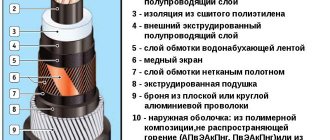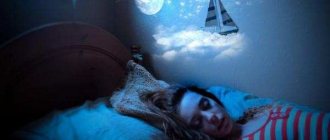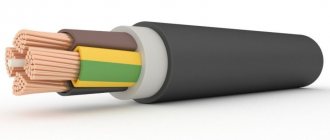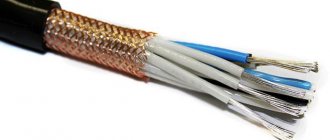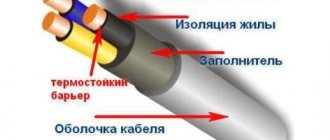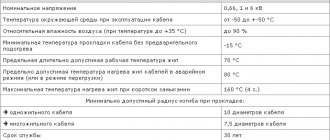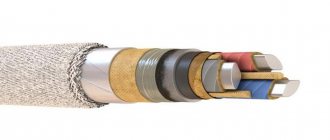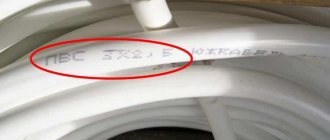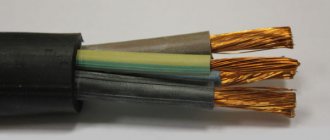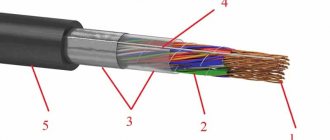The desire to save money when connecting various household appliances or laying electrical wiring often leads to very sad consequences. The question arises: how to ensure the normal and safe functioning of the system, but at the same time avoid unnecessary expenses? The VVGng LS cable is one of the best options for use at home and is very popular among electricians. Why?
What it is
Explanation of symbols on the cable:
- the letter A indicates that the core is made of aluminum; if there is no symbol, it means it is made of copper;
- B means that the insulating layer is made of PVC materials;
- B indicates lack of sealing;
- The ng symbol means that the cable is flame retardant;
- fire hazard type (A)
- LS mark means low smoke emission;
- VVGng-LS - HL - this means that the product can function at critically low temperatures;
- VVGng-LS - T - resistance to mold, fungi, and so on.
What does the product look like?
Other types of cables
In addition to those described above, the VVG line includes the following types of cables:
- VVG is standard, without any special features.
- VVGng FRLS is a wire with increased fire resistance, does not emit smoke, and does not support combustion when laid in one bundle. Designed for use in areas of increased fire and explosion hazard.
- VVGng HF is characterized by increased resistance to heat; in case of a short circuit it can withstand temperatures of 400 degrees.
- VVGng FRHF - HF version with increased fire resistance for fire hazardous areas.
Technical specifications
During emergency operation, the operating temperature should not be higher than 85 degrees. In this case, the total number of hours at high temperature will be 1000.
Marking VVG ng
VVGng product characteristics:
| Permissible air humidity | Not higher than 95% |
| Maximum guarantee | 3 years |
| Test voltage | 3 kV |
| Maximum permissible wire temperature | 85 degrees |
| Maximum permitted voltage | 0.68 kV |
| Laying at ambient temperature | −15 to 10 degrees |
| Product bend radius | 8 outer diameters |
| Permitted minimum and maximum temperatures | From −50 to 70 degrees |
| Critical wire temperature during short circuit | 180 degrees |
There is also a subtype of cable VVGng hf with technical characteristics as indicated above, but with a lower operating temperature. From −45 to 40 degrees.
Description
VVG cables are used to supply power to electrical equipment and lighting both inside buildings and on external cable structures and electrical appliances. Technical characteristics allow it to be used even at sites with relative humidity up to 98% (mines, etc.), as well as for high-altitude air installation. Thanks to this versatility, this conductor is the most popular material for laying networks.
The VVG cable is a wire made of one or more current-carrying cores, each of which has its own insulating layer. These wires are twisted together and laid inside a common insulating sheath. It is made of PVC with low fire hazard, which is very important when installing electrical networks at oil, gas and chemical enterprises. The production of all brands of VVG cable is regulated by the state standard GOST 16442-80.
Scope of application
Products with PVC coating are mainly used in industrial facilities and various domestic areas, since its parameters are excellent for this. The dense coating makes the VVGng power cable quite versatile when it is necessary to transmit electricity through various technical installations.
Wire in section
The VVGng LS type product with a PVC layer showed excellent performance in transmitting high power currents. Using a variety of installations, you can lay both single and multi-core wires, adhering to all GOST rules. This cable model has a high safety class, which increases its service life in various weather conditions.
You might be interested in Pipe heating cable
Note! When burning, the cable produces almost no life-threatening smoke. When manufacturing power wires, much attention is paid to the external insulation, because it protects the cores from various influences, both mechanical and natural.
Almost any power wire of the VVGng LS type is rarely used in the usual installation of an electrical network in residential premises. They are mainly used in factories, enterprises or wooden houses.
Design VVG ng ls
VVGng LS cables are mainly used in areas with increased fire safety regulations. You can lay it either alone or together with others. But for this you will need a terminal block so that the wires do not touch.
It can be laid underground (tunnels, ditches, trenches) or by air. For the latter option, it is necessary to install supports so that the cable does not sag under its own weight.
Fire resistance test. Comparison with NUM cable
Flammability testing of cables with and without the “NG” index. 1. plot: We burn the cable NUM and VVGng-LS under equal conditions; 2. plot: We burn the NUM cable simulating a group laying;
At its core, this cable is not much different from VVG ng - however, there are two differences. For example, round cables (and the core form factor can be round, flat or triangular) use halogen-free filler, as well as unvulcanized rubber, which has a very good degree of fire safety. Also, a special PAH is used for the cable sheath, which has anti-flammability properties, unlike traditional VVG.
Otherwise, the number of cores can vary from one to six, their cross-sections can reach 240 mm2, the diameter also changes in proportion to the cross-sectional area, the permissible current, depending on the type and number of cores, can vary from 21A to 704A, and the weight varies from approximately 40 kg/km to several tons for the same one kilometer. If you decide to buy such a cable, carefully read its description in the store - after all, you may come across a product that does not have the characteristics that you need. The price varies greatly depending on the characteristics, and the cost can increase hundreds of times if the number of cores and their total area increases. The traditional service life of such a product is more than thirty years, of which five are usually under warranty.
Temperature range when using VVGng: from -30°С to +50°С
Relative humidity should be up to 98% at +35 degrees Celsius.
Minimum bending radius when laying
- single-core cables - 10 outer diameters,
- multi-core cables - 7.5 outer diameters.
Long-term permissible heating temperature of cable cores during operation: +70°C
Limit temperature of current-carrying conductors of cables under the condition of non-ignition of the cable during short-circuit: + 400°С
| Number of cores, cross-section, mm2 | VVGng-LS | Number of cores, cross-section, mm2 | VVGng-LS | ||||||
| diameter, mm | weight, kg | diameter, mm | weight, kg | ||||||
| 0.66 kV | 1 kV | 0.66 kV | 1 kV | 0.66 kV | 1 kV | 0.66 kV | 1 kV | ||
| 1x1.5 | 5.9 | 6.3 | 43 | 48 | |||||
| 1x2.5 | 6.2 | 6.6 | 54 | 60 | 3x2.5+1x1.5 | 10.0 | 11.0 | 190 | 215 |
| 1x4 | 6.9 | 7.5 | 75 | 86 | 3x4+1x2.5 | 11.8 | 12.8 | 262 | 302 |
| 1x6 | 7.4 | 8.0 | 98 | 109 | 3x6+1x4 | 12.9 | 14.4 | 359 | 409 |
| 1x10 | 7.7 | 8.0 | 149 | 155 | 3x10+1x6 | 15.3 | 16.3 | 539 | 579 |
| 1x16 | 9.3 | 9.7 | 221 | 227 | 3x16+1x10 | 18.7 | 19.2 | 826 | 858 |
| 1x25 | 10.8 | 11.0 | 322 | 327 | 3x25+1x16 | 22.7 | 23.2 | 1376 | 1408 |
| 1x35 | 11.8 | 12.0 | 415 | 421 | 3x35+1x16 | 22.6 | 23.1 | 1692 | 1723 |
| 1x50 | 13.3 | 13.5 | 556 | 563 | 3x50+1x25 | 24.7 | 25.1 | 2252 | 2288 |
| 1x70 | — | 15.8 | — | 806 | 3x70+1x35 | 28.1 | 28.5 | — | 2708 |
| 1x95 | — | 17.8 | — | 1083 | 3x95+1x50 | 30.8 | — | 3621 | |
| 1x120 | — | 19.5 | — | 1370 | 3x120+1x70 | 34.8 | — | 4576 | |
| 1x150 | — | 21.4 | — | 1658 | 3x150+1x70 | 37.9 | — | 5423 | |
| 1x185 | — | 23.80 | — | 2020 | 3x185+1x95 | 41.8 | — | 6835 | |
| 1x240 | — | 26.60 | — | 2665 | 3x240+1x120 | 45.9 | — | 8787 | |
| 2x1.5 | 7.6 | 8.4 | 93 | 113 | 4x1.5 | 52.0 | 147 | 169 | |
| 2x2.5 | 8.2 | 9.7 | 124 | 156 | 4x2.5 | 9.3 | 10.0 | 196 | 220 |
| 2x4 | 10.2 | 11.4 | 189 | 223 | 4x4 | 10.2 | 11.1 | 284 | 327 |
| 2x6 | 11.3 | 12.4 | 245 | 282 | 4x6 | 11.8 | 13.1 | 377 | 424 |
| 2x10 | 13.6 | 14.0 | 383 | 398 | 4x10 | 13.0 | 14.4 | 592 | 610 |
| 2x16 | 16.1 | 16.5 | 538 | 553 | 4x16 | 15.9 | 16.5 | 887 | 910 |
| 2x25 | 19.4 | 19.8 | 905 | 928 | 4x25 | 19.5 | 20.0 | 1431 | 1472 |
| 2x35 | 21.2 | 21.6 | 1180 | 1205 | 4x35 | 22.7 | 23.2 | 1878 | 1912 |
| 2x50 | 25.0 | 25.4 | 1569 | 1600 | 4x50 | 25.5 | 25.9 | 2493 | 2528 |
| 2x70 | — | 24.3 | 1694 | 4x70 | 29.1 | 29.5 | — | 3056 | |
| 2x95 | 27.0 | 2220 | 4x95 | 31.2 | — | 4102 | |||
| 2x120 | 29.3 | 2723 | 4x120 | 35.5 | — | 5081 | |||
| 2x150 | 31.8 | 3336 | 4x150 | 38.9 | — | 6183 | |||
| 2x185 | 35.0 | 4015 | 4x185 | 42.6 | — | 7701 | |||
| 2x240 | 39.0 | 5190 | 4x240 | 46.7 | — | 10069 | |||
| 3x1.5 | 8.0 | 9.4 | 114 | 143 | 5x1.5 | 52.7 | 180 | 202 | |
| 3x2.5 | 9.3 | 10.2 | 164 | 182 | 5x2.5 | 11.9 | 12.0 | 235 | 263 |
| 3x4 | 10.8 | 12.0 | 233 | 270 | 5x4 | 12.8 | 14.4 | 344 | 394 |
| 3x6 | 11.8 | 13.1 | 310 | 350 | 5x6 | 14.1 | 15.7 | 463 | 519 |
| 3x10 | 14.4 | 14.9 | 480 | 496 | 5x10 | 17.4 | 17.9 | 720 | 756 |
| 3x16 | 16.5 | 17.4 | 681 | 721 | 5x16 | 20.9 | 21.4 | 1078 | 1103 |
| 3x25 | 20.4 | 20.9 | 1167 | 1193 | 5x25 | 25.3 | 25.8 | 1695 | 1735 |
| 3x35 | 22.6 | 23.1 | 1519 | 1548 | 5x35 | 27.9 | 28.4 | 2153 | 2204 |
| 3x50 | 26.4 | 26.8 | 1991 | 2046 | 5x50 | 32.2 | 32.7 | 2900 | 2962 |
| 3x70 | 28.3 | — | 2354 | 5x70 | 36.5 | — | 3858 | ||
| 3x95 | 31.6 | — | 3131 | 5x95 | 39.3 | — | 5101 | ||
| 3x120 | 34.6 | — | 3864 | 5x120 | 43.9 | — | 6304 | ||
| 3x150 | 38.0 | — | 4774 | 5x150 | 47.7 | — | 7815 | ||
| 3x185 | 41.5 | — | 5850 | 5x185 | 53.3 | — | 9569 | ||
| 3x240 | 47.0 | — | 7596 | 5x240 | 59.0 | — | 12406 | ||
Wire design
The composition can contain from 1 to 5 copper wires of different sections, and they can be either single-core or multi-core.
The type of wire can be round or sectored, regardless of how many cores are inside.
Each new core has its own layer of PVC sheath. The external insulation is made of the same material, but more dense.
Copper conductors
The colors of the wires are always different, this is necessary in order not to confuse them. Some models have a neutral core with a small cross-section. Sometimes, instead of colored wires, line markings are used.
The weight of the cable depends on the cross-section of the wires inside. The minimum weight of 1 km will be 38 kilograms for a single-core sector wire with a cross-section of 1.5 mm.
If the same cross-section is used, but there are 2-3 cores inside, then the weight will be from 70 kilograms.
Design features
In the VVGng-LS cable, the minimum number of cores is one, and the maximum number of cores is 5. Each of them has PVC insulation. All of them are enclosed in a PVC shell with special additives that prevent combustion and smoke formation. The size range is quite wide - the TPG cross-section lies in the range of 1-240 mm2.
For ease of installation, the core insulation is multi-colored. Phase conductors can be white, red, blue, black and other colors. The ground wire is always yellow-green in color. And the zero marking is always blue or blue. It is also possible not to completely paint the insulation, but to provide a numerical and alphabetic designation for each conductor (for cross sections larger than 50 mm²), or a color designation in the form of a stripe on a white background.
The cores themselves are made of electrical copper; they can be single-wire (core class 1) in thin cables in the cross-section range of 1-50 mm² or multi-wire (class 2) if the cross-section is in the range of 50-240 mm².
The space between the outer shell and the cores is filled with PVC plastic, which allows the product to be given a round shape. It performs the function of additional insulation, and when burned does not emit harmful substances. The thickness of the insulation depends on the voltage for which the cable is designed.
The power conductors must have an equal cross-section, and one ground wire or neutral conductor often has a smaller diameter.
Depending on the design, the cable can be flat, in which case the letter “P” is added to the marking - VVGng-LS-P, or round, if there is no letter “P” (VVGng-LS).
How to choose VVGng-LS marking cable
Before purchasing, be sure to ask the supplier for documentation. To verify the technical characteristics and choose the right product.
If you need a stranded wire, then you can take a model without crimping, but it will be quite rigid, which can complicate the installation process a little, and they are also difficult to bend.
Types of cable
It is advisable to give preference to copper conductors; although they are cheaper, they are much more efficient than aluminum.
Note! Before purchasing a cable, you can read reviews about manufacturers on thematic forums.
You might be interested in this Features of cross-linked polyethylene cable
Each cable comes with documentation and specifications; if this is not available, then it is better to refuse the purchase. There must be a fire safety certificate.
a brief description of
VVGng power cable is one of the most popular types of conductors, used for the transmission and distribution of electricity in stationary installations at a rated alternating voltage of 660 and 1000 V with a frequency of 50 Hz. The product is used for installation in dry and damp industrial premises, on special cable racks, and in blocks. When laid in bundles, VVGng wire makes it possible to ensure fire safety of cable circuits.
Cable laying methods
There are several methods for laying the VVGng-LS cable.
Public method
Based on the technical parameters of the product, it is allowed to lay on surfaces made of non-combustible raw materials, such as plaster, concrete, brick, and so on.
Laying by air on structures is allowed. But it is necessary to install supports during operation to prevent cable deformation.
Gasket with protective corrugation
For installation in dangerous places that are prone to fire, additional protection is installed in the form of corrugation or cable duct.
Cable support method
Such installations include pipes, cable boxes, etc. This installation method is mainly intended for industrial facilities rather than residential buildings.
When installing wires in industrial enterprises, you must remember the class of the room in which the wire is laid and the ambient temperature.
On cable-supporting installations, installation of the VVG-ng ls product in a bundle is permitted. The number of wires in a bundle is determined by the installation location, fire hazard class and other conditions.
Hidden wire laying method
This is one of the popular options for laying wires in residential buildings.
Underground method
The work is done in the grooves made, under the trim, in voids, and so on. This method does not require additional protection, as it is not subject to defects.
Exceptions include installation in wooden structures. It needs protection against fire and short circuit.
Underground method
A product like VVGng ls is not desirable for installation in the soil, because it does not have natural protection against mechanical damage. But it is permissible to lay such a wire in the ground using additional protection such as corrugations, tunnels, trenches, and so on.
It doesn't matter which installation method is chosen. When working, you must adhere to regulatory documentation.
FRLS and FRHF cable
There are also cables that are more advanced in terms of fire safety with other indexes. However, you must understand that their area of application is quite specific (premises with large numbers of people, hospitals, schools, etc.).
Such special brands are not only more expensive, but it is also not always possible to find them in regular hardware stores. For your home needs, the regular LS version will do just fine.
Also, take into account the size difference. For example, a VVGng FRLS 3*1.5mm2 cable will be the same in diameter as a “simple” VVGng Ls 3*4mm2. In the photo below - on the left is a simple LS at 4mm2, on the right - frls at 1.5mm2.
Even if you have the opportunity and money to purchase such a brand, remember that this will entail additional expenses not only on the wire, but also on fasteners, oversized grooves and other inconvenient installation aspects.
However, in Europe and Western countries, cables simply with the LS index are practically no longer produced. This is explained by its high corrosiveness and high smoke emission compared to other brands (ng-FRHF).
Perhaps our rules will also change in the near future. But for now we use and work according to the instructions that we have.
And why do you need a cable labeled FRLS or FRHF at home? So that the TV, plugged in, will work until the end while the house is on fire?
Such brands are needed primarily for powering operating rooms and intensive care rooms in hospitals, fire protection systems and emergency lighting.
Storage and transportation rules
When moving the product, you must roll the drum carefully without throwing it. Otherwise, you can damage the wires and reduce the service life of the wire. There must be a special crane for moving and loading.
Proper storage in the warehouse
The product should only be stored in a dry room, away from heating devices or open sunlight. From time to time, check the integrity of the packaging, since warehouses are often inhabited by rodents that can damage the casing. Sometimes it is allowed to place cable drums under canopies in the open air. But such stay should not exceed 800 hours in total. There must be a box with sand in the room, which will be needed in case of fire.
You might be interested in Description of the VVG cable
Requirements for transportation of any cables:
- moisture, precipitation and sunlight should not enter the cargo compartment of the vehicle;
- Horizontal movement of the drum is not allowed so as not to damage the cable (except for air transportation);
- The cable drum must be secured in the cargo compartment so that it does not move around during transportation.
Note! The service life of cables depends on how correctly it was stored and transported.
Proper transportation of drums
Manufacturers
Every year more and more cable manufacturers appear on the market. But experienced professionals recommend contacting companies that have been operating for over 10 years and have positive reviews. Below is a list of leading factories on the Russian market.
LLC "GK "Sevkabel"
This is one of the first cable factories in Russia. The plant was founded back in 1879 by a German scientist. The company produces more than 25,000 thousand types of cables. The factory has an impeccable reputation.
Saranskkabel LLC
The factory was founded in 1950. In 2010, the enterprise underwent modernization. The range has been expanded with new cable models. They also have a testing center for cable products.
Indoor storage
LLC "EM-CABLE"
Factory with branches in different parts of the country. They produce cable models with different protection against mold, fungi and insects. Fast delivery and individual approach to each client. They have a high rating in the country.
LLC "KZ "Expert-Cable"
The factory was founded relatively recently, in the spring of 2014. One of the young, but well-established on the Russian market.
The assortment is not so large yet, but it is of high quality. Cables are manufactured using the latest technologies. They also deliver to any corner of the world.
In conclusion, it should be noted that VVGng-LS products are more suitable for large enterprises and industrial facilities. Before purchasing, it is advisable to take a closer look at the above-mentioned factories.

